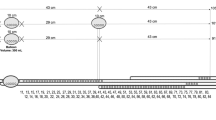Abstract
PURPOSE: Electromyography of the external anal sphincter is frequently used when investigating patients with defecation disorders. Investigations are often performed using an invasive technique by perineal insertion of a needle or wire electrode. The aim of the present study was to investigate whether surface electromyography, with electrodes applied to the perineal skin, is a reliable method in the diagnosis of paradoxical anal sphincter reaction. METHODS: Seventy-one patients with defecation disorders participated in the present study. They were investigated with electromyography of the external anal sphincter using surface and needle electrodes. RESULTS: In 65 of 71 (92 percent) patients the electromyography recording showed the same result during straining using surface electrodes when compared with needle electrodes. Twenty-two of these 65 patients had paradoxical anal sphincter reaction, and 43 patients had decreased electromyography activity. In 6 of 71 (8 percent) patients the electromyography recording showed a different pattern during straining using surface electrodes when compared with needle electrodes. CONCLUSION: The present study demonstrates a good correlation between surface electrodes applied to the perineal skin and concentric needle electrodes in the diagnosis of paradoxical anal sphincter reaction. Noninvasive electromyography recordings of the external anal sphincter are often preferred in the diagnosis of paradoxical anal sphincter reaction.
Similar content being viewed by others
References
Porter NH. A physiological study of the pelvic floor in rectal prolapse. Ann R Coll Surg Engl 1962;31:379–404.
Kuijpers HC, Bleijenberg G, de Morree H. The spastic pelvic floor syndrome. Large bowel outlet obstruction caused by pelvic floor dysfunction: a radiological study. Int J Colorectal Dis 1986;1:44–8.
Johansson C, Nilsson BY, Mellgren A, Dolk A, Holmström B. Paradoxical sphincter reaction and associated colorectal disorders. Int J Colorectal Dis 1992;7:89–94.
Preston DM, Lennard-Jones JE. Anismus in chronic constipation. Dig Dis Sci 1985;30:413–8.
Miller R, Duthie GS, Bartolo DC, Roe AM, Locke-Edmunds J, Mortensen NJ. Anismus in patients with normal and slow transit constipation. Br J Surg 1991;78:690–2.
Felt-Bersma RJ, Strijers RL, Janssen JJ, Visser SL, Meuwissen SG. The external anal sphincter: relationship between anal manometry and anal electromyography and its clinical relevance. Dis Colon Rectum 1989;32:112–6.
Barnes PR, Lennard-Jones JE. Function of the striated anal sphincter during straining in control subjects and constipated patients with a radiologically normal rectum or idiopathic megacolon. Int J Colorectal Dis 1988;3:207–9.
Wexner SD, Marchetti F, Salanga VD, Corredor C, Jagelman DG. Neurophysiologic assessment of the anal sphincters. Dis Colon Rectum 1991;34:606–12.
Johansson C, Nilsson BY, Holmström B, Dolk A. Is paradoxical sphincter reaction provoked by needle electrode electromyography? Dis Colon Rectum 1991;34:1109–12.
Eisman E, Tries J. A new probe for measuring electromyographic activity from multiple sites in the anal canal. Dis Colon Rectum 1993;36:946–52.
Pinho M, Hosie K, Bielecki K, Keighley MR. Assessment of noninvasive intra-anal electromyography to evaluate sphincter function. Dis Colon Rectum 1991;34:69–71.
Keisswetter H. EMG patterns of pelvic floor muscles with surface electrodes. Urol Int 1976;31:60–9.
Floyd WF, Walls EW. Electromyography of the sphincter ani externus in man. J Physiol 1953;122:599–609.
Mellgren A, Anzén B, Nilsson BY,et. al. Results of rectocele repair: a prospective study. Dis Colon Rectum 1995;38:7–13.
Singles JM, Mikulka PJ, Cox DJ, Mittal RK. An alternative biofeedback-based behavior modification treatment for a case of chronic constipation. J Behav Ther Exp Psychiatry 1992;23:231–5.
Glia A, Gylin M, Gullberg K, Lindberg G. Biofeedback retraining in patients with functional constipation and paradoxical puborectalis contraction: comparison of anal manometry and sphincter electromyography for feedback. Dis Colon Rectum 1997;40:889–95.
Barrett DM. Disposable (infant) surface electrocardiogram electrodes in urodynamics: a simultaneous comparative study of electrodes. J Urol 1980;124:663–5.
Nielsen KK, Kristensen ES, Qvist N,et. al. A comparative study of various electrodes in electromyography of the striated urethral and anal sphincter in children. Br J Urol 1985;57:557–9.
Kumar D, Waldron D, Williams NS, Browning C, Hutton MR, Wingate DL. Prolonged anorectal manometry and external anal sphincter electromyography in ambulant human subjects. Dig Dis Sci 1990;35:641–8.
Neill ME, Swash M. Increased motor unit fibre density in the external anal sphincter muscle in ano-rectal incontinence: a single fibre EMG study. J Neurol Neurosurg Psychiatry 1980;43:343–7.
Kiff ES, Swash M. Slowed conduction in the pudendal nerves in idiopathic (neurogenic) faecal incontinence. Br J Surg 1984;71:614–6.
Altman DG. Practical statistics for medical research. London: Chapman and Hall, 1991.
Siroky MB. Electromyography of the perineal floor. Urol Clin North Am 1996;23:299–307.
Keighley MR, Shouler P. Outlet syndrome: is there a surgical option? J R Soc Med 1984;77:559–63.
Binnie NR, Kawimbe BM, Papachrysostomou M, Clare N, Smith AN. The importance of the orientation of the electrode plates in recording the external anal sphincter EMG by non-invasive anal plug electrodes. Int J Colorect Dis 1991;6:5–8.
Wexner SD, Cheape JD, Jorge JM, Heymen S, Jagelman DG. Prospective assessment of biofeedback for the treatment of paradoxical puborectalis syndrome. Dis Colon Rectum 1992;35:145–50.
Bleijenberg G, Kuijpers HC. Biofeedback treatment of constipation: a comparison of two methods. Am J Gastroenterol 1994;89:1021–6.
Papachrysostomou M, Smith AN. Effects of biofeedback on obstructive defecation-reconditioning of the defecation reflex? Gut 1994;35:252–6.
Sörensen M, Tetzschner T, Rasmussen OÖ, Christiansen J. Relation between electromyography and anal manometry of the external anal sphincter. Gut 1991;32:1031–4.
Parks TG. The usefulness of tests in anorectal disease. World J Surg 1992;16:804–10.
Tjandra JJ, Milsom JW, Schroeder T, Fazio VW. Endoluminal ultrasound is preferable to electromyography in mapping anal sphincter defects. Dis Colon Rectum 1993;36:689–92.
Author information
Authors and Affiliations
Additional information
Supported by grants from Kjell and Märta Beijers Stiftelse, Marianne and Marcus Wallenbergs Stiftelse, Bert von Kantzow's Research Foundation, and Karolinska Institutet Research Funds.
About this article
Cite this article
López, A., Nilsson, B.Y., Mellgren, A. et al. Electromyography of the external anal sphincter. Dis Colon Rectum 42, 482–485 (1999). https://doi.org/10.1007/BF02234172
Issue Date:
DOI: https://doi.org/10.1007/BF02234172




